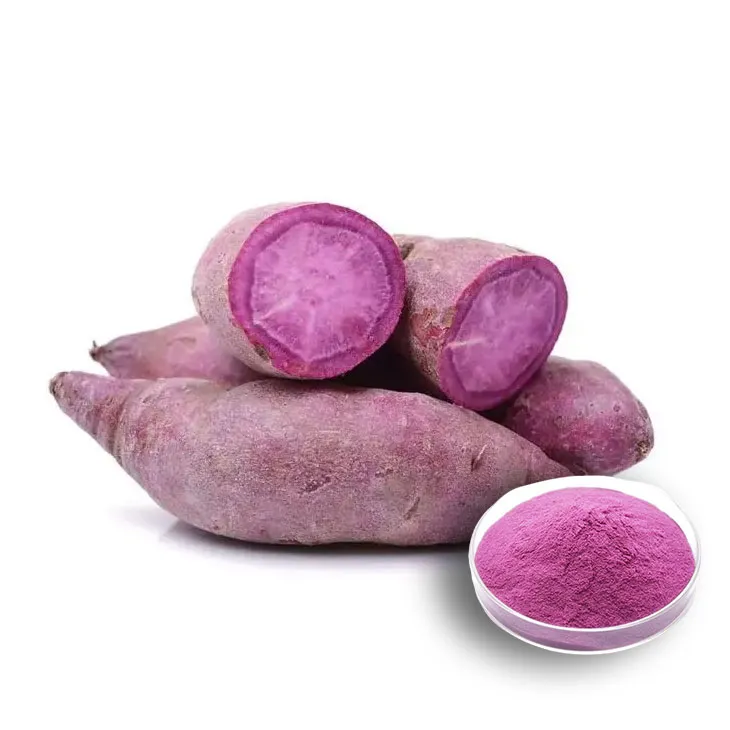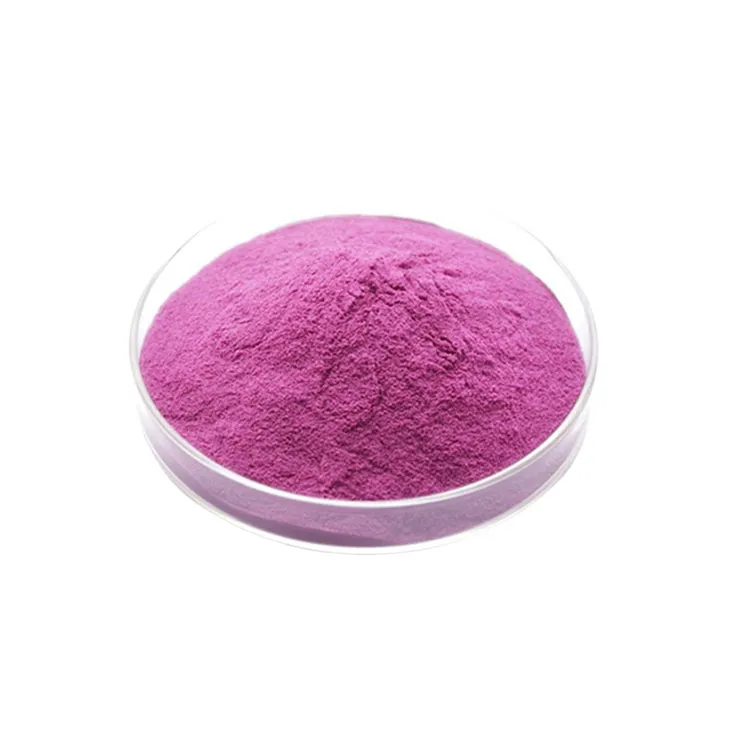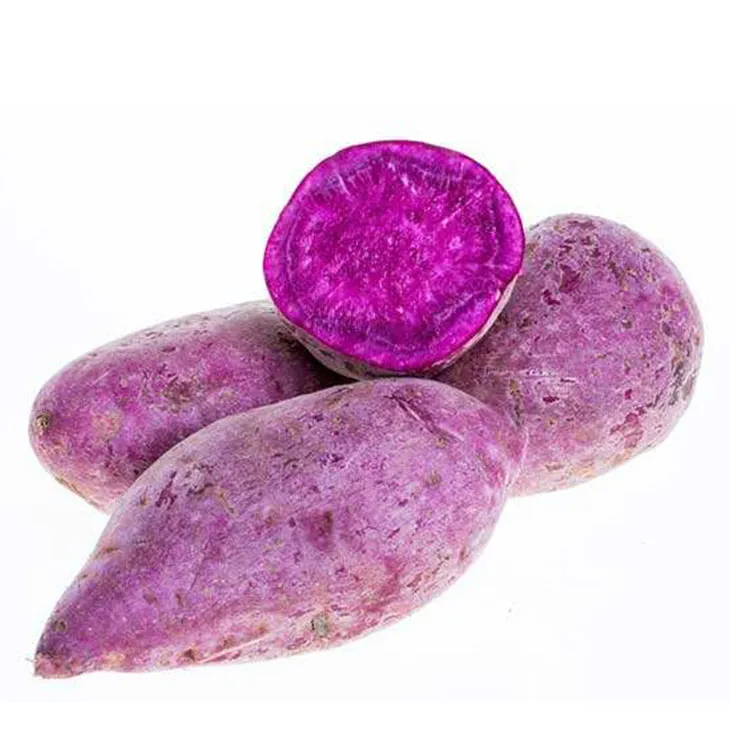- 0086-571-85302990
- sales@greenskybio.com
Extraction technology and production process of purple sweet potato extract.
2024-11-30

1. Introduction
Purple Sweet Potato Extract has been gaining significant attention in recent years due to its rich content of beneficial components. These components include anthocyanins, which are well - known for their antioxidant properties, as well as other nutrients like dietary fiber, vitamins, and minerals. The extraction of Purple Sweet Potato Extract is a complex process that involves several steps and different extraction technologies to ensure the final product has the desired quality, purity, and potency.

2. Extraction Methods
2.1 Solvent Extraction
Solvent extraction is one of the most commonly used methods for extracting Purple Sweet Potato Extract. The principle behind this method is to use a suitable solvent to dissolve the target components effectively from the purple sweet potato matrix.
Selection of Solvents: Ethanol is a frequently chosen solvent for purple sweet potato extraction. It has several advantages. Firstly, it is relatively safe compared to some other organic solvents. Secondly, it has a good solubility for anthocyanins and other bioactive components present in purple sweet potatoes. The concentration of ethanol used can vary depending on the specific requirements of the extraction process. Generally, a concentration range of 50% - 80% ethanol is often used.
Extraction Procedure: The purple sweet potato is first washed and peeled to remove any dirt or impurities. Then, it is cut into small pieces or mashed to increase the surface area available for extraction. The prepared purple sweet potato material is then mixed with the ethanol solvent in a suitable ratio. This mixture is usually stirred or shaken for a certain period, typically ranging from a few hours to several days at a controlled temperature. The extraction time and temperature need to be optimized to achieve the highest extraction efficiency while maintaining the stability of the bioactive components.
2.2 Ultrasonic - Assisted Extraction
Ultrasonic - assisted extraction is an innovative extraction method that has shown great potential in enhancing the extraction efficiency of purple sweet potato extract.
Principle: Ultrasonic waves are applied during the extraction process. These ultrasonic waves create cavitation bubbles in the solvent - purple sweet potato mixture. When these bubbles collapse, they generate high - intensity shock waves and micro - jets. These physical forces can effectively break the cell walls of purple sweet potato cells, which otherwise act as a barrier to the release of the target components. By breaking the cell walls, the bioactive components such as anthocyanins are more easily released into the solvent, thus increasing the extraction efficiency.
Procedure: Similar to solvent extraction, the purple sweet potato is pre - treated by washing, peeling, and cutting or mashing. The pre - treated material is then placed in the extraction vessel along with the solvent (e.g., ethanol). Ultrasonic waves are then applied at a specific frequency and power for a defined period. The frequency of the ultrasonic waves can range from 20 kHz to 100 kHz, and the power can be adjusted according to the scale of the extraction process. The extraction time is usually shorter compared to traditional solvent extraction, typically ranging from 30 minutes to a few hours.

3. Production Process
3.1 Raw Material Pre - treatment
Quality Selection of Purple Sweet Potatoes: The first step in the production process of purple sweet potato extract is to ensure the quality of the raw material. High - quality purple sweet potatoes should be selected. This includes choosing sweet potatoes that are free from diseases, pests, and mechanical damage. The variety of purple sweet potato also plays an important role as different varieties may have different contents of bioactive components.
Washing and Cleaning: Once the purple sweet potatoes are selected, they need to be thoroughly washed to remove any soil, debris, or surface contaminants. This can be done using clean water and gentle agitation. After washing, the sweet potatoes are drained to remove excess water.
Peeling and Size Reduction: Peeling is usually necessary to remove the outer skin, which may contain unwanted substances or have a negative impact on the quality of the extract. After peeling, the purple sweet potatoes are cut into small pieces or mashed. This size reduction step increases the surface area available for extraction, which is beneficial for improving the extraction efficiency in the subsequent steps.
3.2 Extraction
Depending on the chosen extraction method (either solvent extraction or ultrasonic - assisted extraction), the pre - treated purple sweet potato material is subjected to the extraction process. As described earlier, in solvent extraction, the purple sweet potato pieces or mash are mixed with the solvent (e.g., ethanol) and stirred or shaken for an appropriate time at a controlled temperature. In ultrasonic - assisted extraction, ultrasonic waves are applied during the extraction process with the purple sweet potato and solvent mixture.
3.3 Purification
Filtration: After the extraction step, the resulting mixture contains the purple sweet potato extract along with solid residues such as cell debris. Filtration is the first step in purification. There are different types of filtration methods that can be used, such as vacuum filtration or pressure filtration. Vacuum filtration is often preferred as it can effectively separate the liquid extract from the solid residues without causing significant damage to the bioactive components.
Chromatographic Purification: In some cases, more advanced purification methods such as chromatographic techniques may be required to achieve a higher purity of the purple sweet potato extract. For example, column chromatography can be used to separate different components based on their differential adsorption and desorption properties on the chromatographic column. This can help in isolating the anthocyanins and other desired components from other impurities present in the extract.
3.4 Concentration
Evaporation: After purification, the purple sweet potato extract may still contain a large amount of solvent. Evaporation is a common method used to concentrate the extract. This can be achieved by heating the extract under reduced pressure. The reduced pressure helps to lower the boiling point of the solvent, which in turn reduces the time required for evaporation and minimizes the potential damage to the bioactive components due to over - heating.
Freeze - Drying: Another method for concentration is freeze - drying. In this process, the purple sweet potato extract is first frozen and then placed under a vacuum. Under these conditions, the ice in the extract sublimes directly from the solid state to the gas state, leaving behind a concentrated extract. Freeze - drying is often used when a high - quality, powder - like extract is desired as it can better preserve the structure and activity of the bioactive components.

4. Conclusion
In conclusion, the extraction technology and production process of purple sweet potato extract are complex but crucial for obtaining a high - quality product. The choice of extraction method, whether it is solvent extraction or ultrasonic - assisted extraction, needs to be carefully considered based on factors such as extraction efficiency, cost, and the desired quality of the final product. The production process, which includes raw material pre - treatment, extraction, purification, and concentration, also plays a vital role in ensuring the purity, potency, and stability of the purple sweet potato extract. With the increasing demand for natural and healthy products, understanding and optimizing these aspects of purple sweet potato extract production will be essential for the industry to meet the market requirements and provide consumers with high - quality purple sweet potato extract - based products.

FAQ:
What are the common solvents used in solvent extraction of purple sweet potato extract?
Ethanol is one of the commonly used solvents in solvent extraction of purple sweet potato extract. It is effective in dissolving the target components. Other solvents may also be considered depending on the specific properties of the components to be extracted, but ethanol is often preferred due to its relatively safe nature and good solubility for many of the beneficial substances in purple sweet potatoes.
How does ultrasonic - assisted extraction enhance the extraction efficiency of purple sweet potato extract?
Ultrasonic - assisted extraction enhances the extraction efficiency of purple sweet potato extract by using ultrasonic waves. These waves create high - frequency vibrations that can break the cell walls of purple sweet potato cells. When the cell walls are broken, the target components inside the cells are more easily released and can be dissolved into the solvent, thus increasing the overall extraction efficiency compared to traditional extraction methods without ultrasonic assistance.
What are the key points in the raw material pre - treatment for purple sweet potato extract production?
The key points in raw material pre - treatment for purple sweet potato extract production include cleaning the purple sweet potatoes thoroughly to remove dirt, debris, and any surface contaminants. Sorting is also important to eliminate damaged or diseased sweet potatoes. Additionally, proper cutting or chopping of the purple sweet potatoes into appropriate sizes can help in subsequent extraction steps, ensuring better contact between the raw material and the extraction solvent.
Why is purification important in the production process of purple sweet potato extract?
Purification is important in the production process of purple sweet potato extract because it helps to remove impurities. The raw extract obtained after the initial extraction may contain substances other than the desired beneficial components, such as proteins, fibers, and other compounds. Purification ensures that the final extract has the desired purity, which is crucial for applications where a high - quality and consistent product is required, for example, in the food, pharmaceutical, or cosmetic industries.
How is the concentration step carried out in the production of purple sweet potato extract?
The concentration step in the production of purple sweet potato extract can be carried out through methods such as evaporation. This involves removing the solvent from the extract under controlled conditions. For example, in the case of using ethanol as a solvent, heat can be applied in a controlled manner to evaporate the ethanol, leaving behind a more concentrated form of the purple sweet potato extract. Other techniques like membrane filtration may also be used depending on the specific requirements of the production process.
Related literature
- Purple Sweet Potato: Nutritional Value, Bioactive Compounds and Health Benefits"
- "Extraction and Characterization of Bioactive Compounds from Purple Sweet Potato"
- "Advanced Extraction Technologies for Purple Sweet Potato Extracts in the Food Industry"
- ▶ Hesperidin
- ▶ Citrus Bioflavonoids
- ▶ Plant Extract
- ▶ lycopene
- ▶ Diosmin
- ▶ Grape seed extract
- ▶ Sea buckthorn Juice Powder
- ▶ Fruit Juice Powder
- ▶ Hops Extract
- ▶ Artichoke Extract
- ▶ Mushroom extract
- ▶ Astaxanthin
- ▶ Green Tea Extract
- ▶ Curcumin
- ▶ Horse Chestnut Extract
- ▶ Other Product
- ▶ Boswellia Serrata Extract
- ▶ Resveratrol
- ▶ Marigold Extract
- ▶ Grape Leaf Extract
- ▶ New Product
- ▶ Aminolevulinic acid
- ▶ Cranberry Extract
- ▶ Red Yeast Rice
- ▶ Red Wine Extract
-
Lavender Extract
2024-11-30
-
Troxerutin
2024-11-30
-
American Ginseng Root Extract
2024-11-30
-
Avocado Extract Powder
2024-11-30
-
Europen Bilberry Extract
2024-11-30
-
Giant Knotweed Extract
2024-11-30
-
Fig Extract
2024-11-30
-
Dandelion Root Extract
2024-11-30
-
Cassia Seed Extract
2024-11-30
-
Yam Extract
2024-11-30





















